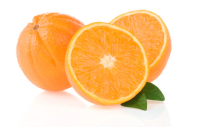Oranges
 One of the most commonly purchased fruits in today's world is the orange. Just one orange can provide the minimum daily requirement of vitamin C with 65 mg, and one glass of orange juice contributes a tremendous 125 mg of this important vitamin. Oranges can fight cancer, stop inflammation and lower the risk for stroke and heart disease.
One of the most commonly purchased fruits in today's world is the orange. Just one orange can provide the minimum daily requirement of vitamin C with 65 mg, and one glass of orange juice contributes a tremendous 125 mg of this important vitamin. Oranges can fight cancer, stop inflammation and lower the risk for stroke and heart disease.
Overview
This round citrus fruit ranges in diameter from between 2 to 3 inches. Oranges are orange on the outside and on the inside. There are several varieties of oranges, including navel, Jaffa and Valencia. The blood orange is a hybrid that is smaller and more aromatic in flavor. Bitter oranges are typically used to make marmalade or jam and the zest from these oranges is used for flavoring liqueurs such as Cointreau and Grand Marnier.
History
The orange is referred to in the Chinese traditional text The Five Class which was published in about 500 B.C. This fruit was first cultivated in the 19th Century in the Middle East. During the 15th Century, various explorers and traders introduced sweet oranges to Europe. Spanish explorers transported oranges to Florida in the 16th Century. In the 18th Century, missionaries from Spain brought the orange to California for cultivation as well.
Oranges are the leading fruit crop in the U.S. Brazil, Spain, Israel, China and Mexico are other world producers of this fruit.
Nutritional Information
Aside from being an excellent source of vitamin C, oranges are also a good source of flavonoids. Oranges are also a good source of the B vitamins, including vitamins B1, B2 and B6. They also contain folic acid, pantothenic acid, pectin, carotenes, and potassium.
This tasty fruit also contains 3 grams of fiber, which is about 12 percent of the recommended daily intake for fiber. Oranges also contain soluble fiber (which includes pectin), known to help lower cholesterol and control changes in blood sugar.
Health Benefits
Oranges can be important in the human body wherever vitamin C is needed to function, including the immune system, the adrenal glands, and the lens of the eyes. Vitamin C is also necessary for the reproductive organs and the connective tissues, which includes the joints and the gums.
One study measured the total antioxidant capacity of oranges. Surprisingly, vitamin C only accounted for 15 to 20 percent of the total antioxidant activity. The other compounds in oranges also were discovered to be strong antioxidants, with anywhere from three to six times the antioxidant potency of the vitamin C.
An important flavonoid in oranges is hesperidin, which has been shown to lower high blood pressure and cholesterol in studies with animals. This fruit also has very strong anti-inflammatory properties. Because oranges do not negatively affect the stomach lining as aspirin can, in the future oranges may be used to help reduce inflammation in those people who are sensitive to anti-inflammatory drugs.
Consuming orange juice and oranges has been proven to aid in protecting against the onset of cancer and to help fight viral infections. The pectin in oranges is similar to the pectin in grapefruit in that it helps to lower cholesterol levels.
Safety
Oranges are a common food allergen, so caution should be used by those who have known allergies to this fruit. The peel contains oxalate. People who have a history of calcium oxalate-containing kidney stones should limit or avoid consumption of oranges.
Oranges are among the foods on which pesticide residues are most frequently found, so this fruit should be thoroughly washed before eating. Oranges should also be washed to avoid the possibility of germs and bacteria entering the flesh when the fruit is cut.
Selecting and Storing
Oranges should be chosen for their firmness and the texture of the skin. Lighter fruit has a drier pulp and more skin, so they also contain less juice. Oranges that are bruised, moldy, or soft should be avoided. However, brown or green oranges could be as ripe and tasty as those with a more typical color.
This fruit can be stored at room temperature for approximately two weeks. Oranges can also be stored in the refrigerator for up to two weeks. Oranges should not be wrapped: when wrapped, oranges are more susceptible to mold.
Orange peel can be dried and stored in airtight containers. The juice from oranges can be squeezed and put into ice cube trays and frozen. Once frozen, the cubes can be stored in the freezer in plastic bags.
Serving Ideas for Oranges
Because of their sweetness, oranges are excellent simply peeled and eaten. This fruit is also good in salads. An easy recipe is to lightly saute onions, then deglaze the pan with orange juice. The liquid can be used as a marinade and sauce for grilled tofu.
Cooked carrots can be blended with orange juice and seasoned with rosemary. Serve the mixture as a cold soup. A simple salad can be made using orange segments, fennel and shaved parmesan cheese.
References
- Holford, P.(2004). The optimum nutrition bible. London : Piatkus
- Holford, P & Lawson, S. (2008). Optimum Nutrition Made Easy How to achieve optimum health. London : Piatkus
- Murray, M.T. et al.(2005). Encyclopedia of healing foods. London : Piatkus
- Yeager, S. & Prevention Health Books. (1998). The doctors book of food remedies : the newest discoveries in the power of food to cure and prevent health problems from aging and diabetes to ulcers and yeast infections. [Emmaus, Pa.] : Rodale
Posted in Oranges
Ask a Question Or Join a Discussion


